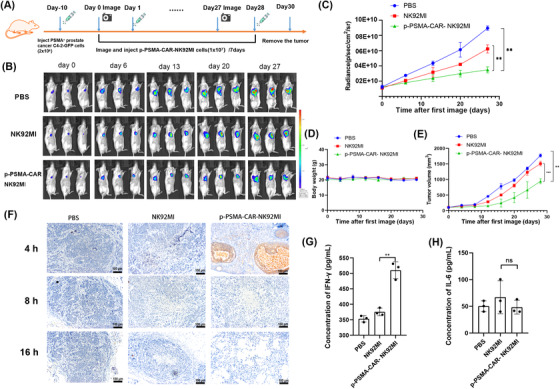FIGURE 5.

p‐PSMA‐CAR‐NK92MI cells significantly repressed CRPC tumor proliferation in vivo. (A) Diagram of the experimental design of the CRPC xenograft model. On day 0, the tumor burden (∼100 mm3) was measured, and the mice were randomly grouped. Of note, day 0 was defined as the day before CAR‐NK cell treatment. PBS, NK92MI cells or p‐PSMA‐CAR‐NK92MI cells (1×107 per mouse in 150 μL of PBS) were injected via the lateral tail vein on the following day and then every 7 days. (B) The C4‐2‐GFP tumor was monitored weekly by bioluminescent imaging. The tumor burdens of CRPC xenograft‐bearing mice treated with p‐PSMA‐CAR‐NK92MI cells, parental NK‐92MI cells, or PBS are shown. (C) The tumor burden was evaluated by bioluminescence imaging. p‐PSMA‐CAR‐NK92MI cells resulted in a significant reduction in the tumor burden at 27 days compared with that observed with either PBS or NK92MI cells. (D) The body weights did not significantly differ among the groups from B. (E) Disease progression was halted in mice treated with p‐PSMA‐CAR‐NK92MI cells from B, and a reduction in CRPC volume was observed at 27 days. (F) Immunohistochemical staining for CD56 was performed with tumor samples at 4, 8, or 16 hours after injection of PBS, NK92MI cells or p‐PSMA‐CAR‐NK92MI cells. p‐PSMA‐CAR‐NK92MI cells exhibited a more consistent tumoricidal performance than NK92MI cells. Scale bar: 100 μm. (G) The IFN‐γ levels in the tail vein blood of mice collected at 24th hour after PBS, NK92MI cells or p‐PSMA‐CAR‐NK92MI cell infusion were detected by ELISA. (F) The TNF‐a levels at 24th hour after NK92MI cell PBS, NK92MI cells or p‐PSMA‐CAR‐NK92MI cell infusion were detected by ELISA. The data are presented as the means ± SEMs from three independent experiments. **, P <0.01; ***, P <0.001; ****, ns, not significant. Abbreviations: CRPC, castration‐resistant prostate cancer. ELISA, enzyme linked immunosorbent assay; IFN‐γ, interferon gamma; TNF‐α, tumor necrosis factor‐α; GFP, green fluorescent protein; SEM, standard error of the mean
